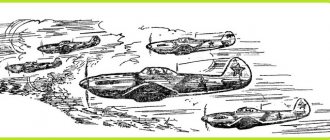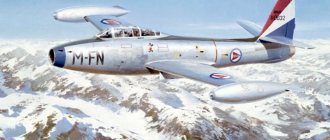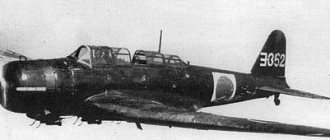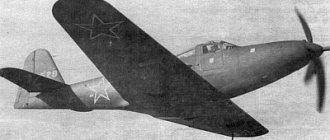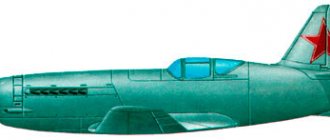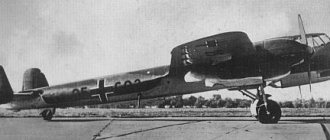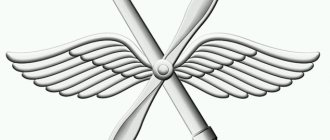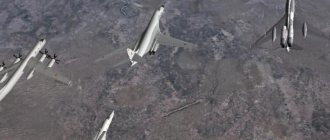The best Japanese fighter of World War II Nakajima Ki-84
The Nakajima Ki-84 was a single-engine all-metal monoplane fighter, conceived as a machine that combined the maneuverability of the Ki-43 with the high speed and climb rate inherent in the Ki-44, as well as powerful weapons. Additionally, it was necessary to radically reduce the complexity of manufacturing the aircraft. The requirements for the new vehicle, submitted on December 29, 1941, included armament with 2 20 mm cannons and 2 12.7 mm machine guns. 14-cylinder Nakajima X-45 engine with an estimated power of about 2000 hp. was supposed to provide a maximum speed of 680 km/h.
The development of the aircraft was headed by Y. Koyama. The preliminary design was approved on May 27, 1942, after which the vehicle was given the designation Ki-84. Testing of the first prototype Ki-84.01 began at the end of April, and the second Ki-84.02 - in June 1943. In August, the production of pre-production Ki-84 began - they were built in Ota. Serial aircraft were produced by the same enterprise from April, and by plant No. 4 in Utsunomiya - from May 1944. In March 1945, production of the Ki-84 began at the Maneyu Hikoki enterprise in Harbin (Manchuria), but only 95 aircraft were assembled here. Plant No. 1 produced 2,561 aircraft, No. 4 - 727. Thus, the total production volume, taking into account pre-production aircraft, amounted to 3,510 aircraft , of which the Imperial Army Air Force accepted 3,470 aircraft. In the Allied code system it was designated "Frank".
Main modifications of the Nakajima Ki-84 “Hayate”
Ki -84 - pre-production batch (125 units). Engine Kha-45-11 (1825 hp). Armament: 2 20-mm Ho-5 cannons in the wing (150 rounds of ammunition each) and 2 12.7-mm Ho-103 synchronized machine guns in the fuselage (350 rounds each).
Ki -84 Ko (“fighter aircraft, army type 4 model Ko”) - the main production version. The armament corresponds to pre-production vehicles. Under the wing there is a suspension of two aerial bombs with a caliber of 30-250 kg. The first batches were equipped with the Kha-45-11 engine, later - the Kha-45-12 (1850 hp). Then an option appeared with the Kha-45-21 engine (2100 hp). But since the problems in the operation of the fuel system, which were noted on pre-production vehicles, could not be eliminated, a solution was found in installing the Kha-45-23 engine (1925 hp), equipped with a fuel injection system with reduced operating pressure. All engine options were equipped with a water-methanol mixture injection system, and the fuselage had a tank for 130 liters of such a mixture.
Ki -84 Otsu (“type 4 Otsu model”) - the armament was strengthened by replacing the fuselage machine guns with Ho-5 cannons. The number of aircraft produced is unknown, but it probably did not exceed 10% of the total Ki-84 production.
Ki -84 Hei (“type 4 Hei model”) - 2 30-mm Ho-155-II cannons are installed in the wing, 2 20-mm Ho-5 cannons are installed in the fuselage. Some aircraft received only one 30-mm cannon in the right console (a 20-mm cannon was installed in the left). A small number were built. The latest series of Ki-84 Otsu and Ki-84 Hei received Kha-45-25 engines (2025 hp).
The Ki -84 Tey (“type 4 Tey model”) is a fighter designed to attack enemy bombers from below. In addition to the 4 Ho-5 cannons found on the Ki-84 Otsu, a fifth identical cannon is installed behind the cockpit, firing forward and upward at an angle of 45°. Only two prototypes were built.
Ki -84- ll (“type 4 model 2”) - an aircraft with partial replacement of duralumin components with wooden ones (in the tail, tail, wingtips), produced since the spring of 1945 by the Ota plant. The designation was unofficial, since the military designated the “wooden” aircraft as Ki-84 Otsu or Ki-84 Hei, depending on the installed weapons. The number of manufactured Ki-84-lls has not been established, since separate records of produced vehicles of this modification were not kept. The Ki-84-I aircraft were equipped with Kha-45-21, -23 or -25 engines.
The Ki-106 (an all-wood version of the Ki-84 developed), the Ki-113 (a version developed by Nakajima with partial replacement of aluminum parts with steel) and the Ki-116 (a modified version with a Mitsubishi engine) were tested, but did not have time to get into production. Kha-33-62). A number of modifications were still not completed until the Japanese surrender.
About 20 Ki-84 aircraft were converted into two-seat trainers in the field at the end of 1944. At the same time, there were no controls in the instructor’s cabin, and he could only help the trainee with instructions.
Operational service[edit]
The first major operational intervention was during the Battle of Leyte in late 1944, and from that point until the end of the Pacific War the Ki-84 was used wherever intense fighting took place. [8] 22nd Sentai converted to Hayates production. Although it lacked high altitude performance, it performed well at mid and low levels. Having seen action against the USAAF's 14th Air Force, it quickly gained a reputation as a combat aircraft to be reckoned with. weapons and models of fighter-bombers arrived. On April 15, 1945, 11 Hayates attacked American airfields on Okinawa, destroying many aircraft on the ground.
In the final year of the war, the Ki-84, Ki-100 (essentially a radial engine version of the Kawasaki Ki-61) and Kawanishi's N1K2-J were the three Japanese fighters best suited to fight the new allies. fighters.
See also[edit]
Related development
- Nakajima Ki-43
- Nakajima Ki-44
- Nakajima Ki-116
Aircraft of comparable role, configuration and era
- Focke-Wulf Fw 190
- Hawker Tempest
- Kawanishi N1K
- Kawasaki Ki-100
- Lavochkin La-7
- Mitsubishi A7M
- Nakajima Ki-87
- North American P-51 Mustang
- Republic P-47 Thunderbolt
- Supermarine Spitfire (Griffin variants)
- Yakovlev Yak-9
- Yakovlev Yak-3 U
- Vought F4U Corsair
Related Lists
- List of World War II aircraft
- List of aircraft of Japan during World War II
Links[edit]
Notes[edit]
- ^ a b c d
Francillon, 1979, p. 238 - ^ a b
Glancey 2006, p. 174. harvnb error: no target: CITEREFGlancey2006 (help) - Ethell 1995, page 103. harvnb error: no target: CITEREFEthell1995 (help)
- ^ a b
Ethel 1995, p. 102. harvnb error: no target: CITEREFEthell1995 (help) - Jump up ↑
Air International & Volume 10 No. 1, pp. 22–29, 43–46. harvnb error: no target: CITEREFAir_InternationalVolume_10_No._1 (help) - Green 1961, p. 79. harvnb error: no target: CITEREFGreen1961 (help)
- USSBS, 1947, p. 78
- ^ a b
Mondey 1996, p. 230. harvnb error: no target: CITEREFMondey1996 (help) - ^ a b
M. Williams Archive, TAIC 156A-1, Frank Report 1 - ^ a b
USSBS, Appendix M, pp. 40–42 - Bueschel 1971, page 52. harvnb error: no target: CITEREFBueschel1971 (help)
- Chiran Peace Museum, Hayate Exhibition Hall
- Pacific Wreck, JAAF Unknown Sentai, Ki-84-I Ko
Bibliography[edit]
- Aviation Staff Aero Publishers Inc. Nakajima Ki-84 (Aero Series 2)
. Fallbrook, CA: Aero Publishers, Inc., 1965. ISBN 0-8168-0504-0. - Buechel, Richard M. Nakajima Ki.84a/b Hayate in Japanese Army Air Force service
. Reading, Berkshire, UK: Osprey Publishing Ltd., 1971. ISBN 0-85045-044-6. - Caruana, Richard J. "Nakajima Ki-84 Hayate" Article number and scale drawings. Scale Aviation Modeller International.
Volume 10, Issue 10 October 2004 Bedford, UK. - Ethel, L. Jeffrey. Airplane of World War II
. Glasgow, HarperCollins, 1995. ISBN 0-00-470849-0. - Francillon, Rene J.
Nakajima Hayate (Airplane in profile, number 70) . Leatherhead, Surrey, UK: Profile Publications, 1966. - Francillon, Rene J. Japanese Aircraft of the Pacific War
. London: Putnam & Company, 1970 (2nd edition, 1979). ISBN 0-370-30251-6. - Glancey, Jonathan. Spitfire: A Biography
. London: Atlantic Books, 2006. ISBN 978-1-84354-528-6. - Green, William. Warplanes of World War II, Volume Three: Fighter Aircraft
. London: Macdonald & Co. (Publishers), 1961 (Seventh Impression, 1973). ISBN 0-356-01447-9. - Green, William and Swanborough, Gordon. World War II Aircraft Facts: Japanese Army Fighters, Part 2
. London: Macdonald and Jane's Publishers, 1977. ISBN 0-354-01068-9. - Huggins, Mark (May–June 1999). "The Setting Sun: Japanese Air Defense of the Philippines 1944–1945." Air Enthusiast
(81): 28–35. ISSN 0143-5450. - Monday, David. A Quick Guide to Axis Aircraft of World War II
. New York: Bounty Books, 1996. ISBN 1-85152-966-7. - Sakaida, Henry. Japanese Army Air Force Aces 1937–45
. Botley, Oxford, UK: Osprey Publishing, 1997. ISBN 1-85532-529-2. - Sims, Edward H. Fighter Tactics and Strategy 1914–1970
. Fallbrook, CA: Aero Publishers, 1980. ISBN 0-8168-8795-0. - US Strategic Bomber Reconnaissance Aircraft Directorate. Nakajima Aircraft Company, Ltd.
Corporation Report II, Washington, D.C., 1947. - Wieliczko, Leszek A. Nakajima Ki-84 Hayate
. Lublin, Poland: Kagero, 2005. ISBN 83-89088-76-2. (Bilingual Polish/English) - Unknown author "Strong Wind from Ota". Air International
. Volume 10 No. 1 - Various authors. Yon-Shiki Sentoki Hayate (Pacific War No. 46)
. Tokyo, Japan: Gakken, 2004. ISBN 4-05-603574-1.
Ki-84
- Nakajima-Ota Plant Management
- Ki. 43
- Ki. 44
- A6M Zero
TTZ of the Ground Forces
At the end of 1941, the Main Aviation Directorate of the Imperial Japanese Ground Forces turned to the Nakajima Aviation Design Bureau with a request to develop a single fighter based on the Ki interceptor. 44 with greater maneuverability. The position of the Ground Forces on a promising single fighter included the following requirements:
- speed up to 700 km/h
- aircraft engine D-45 (Nakajima-Slava, radial, 18-cyl.)
- loitering 90 min. at a distance of 400 km from the airfield with air combat in the zone
- cannon and machine gun weapons
- protection of the pilot and fuel tanks
Design and testing
- IAE vehicle No. 73 (military unit Tokorozawa
After maneuverable Ki. 27 and Key. 43 and Ki interceptor. 44, the Nakajima Design Bureau team under the leadership of chief designer Ya. Koyama developed a single fighter under the factory code Ki. 84. The preliminary design of a single fighter for the Ground Forces was presented by Ki. 44 with a D-45 engine, a new wing and an increased fuel supply. The Main Directorate of Aviation of the Ground Forces planned to put a single fighter into service simultaneously in all theaters of operations. During the development process, the requirements for range grew while maintaining maneuverability at the level of front-line Ki. 43. The combination of requirements determined the limitation of the wing load to 155 kg/sq. m., which did not fit into the Ki design. 44. With fuel reserve, armored back and tank protector, the design weight was more than 3 tons, which sharply increased the wing load. It was decided to increase the wing area to 21 sq.m. (the empty weight of the new project was equal to the curb weight of Ki. 44). After the preparation of design and technical documentation, in the spring of 1942, construction of a pilot batch began at the Nakajima-Ota plant.
In the first half of 1943, an experimental pair with a D-45 (up to 1.8 thousand hp), exhaust manifolds, underwing tanks and uncapped weapons was tested at the Ojima factory airfield, after which it was transferred to the Aviation Research Institute (military unit Tachikawa) and the Air Reception Directorate of the Ground Forces (military unit Fuss). In the spring of 1943, a test pilot of the Ground Forces (Major of the Air Reception Department D. Iwahashi) gave a flattering description of the vehicle in the presence of a team of designers. During military tests, vibration of the VIS and failures of the D-45 were revealed, and at the suggestion of the commander of the IAE aviation acceptance department (the son of the head of the Main Aviation Administration, Major Y. Aramaki), a second pilot batch of 10 vehicles was ordered. In 1943, up to 100 units. pre-production vehicles underwent extensive testing at the Aviation Research Institute and the Aircraft Acceptance Department. During testing, the horizontal speed exceeded 620 km/h, which was lower than the customer's requirements, but higher than the speed of combat vehicles. Technological and structural improvements were carried out on the machines (the stabilizer and rudder were redesigned to increase take-off stability), at the beginning of 1944. on o. Several Hokkaido vehicles were equipped with skis on racks at the root of the wing. In the spring of 1944, the fighter was adopted by the Ground Forces aviation under the code Ki. 84 (Japanese Rikugun yonshiki sentoki
).
During the replacement of digital aircraft ciphers with proper names Ki. 84 was designated Storm (Japanese: Hayate
).
Operators[edit]
War time
Japan
- Imperial Japanese Army Aviation Service
Postwar
People's Republic of China
- The People's Liberation Army Air Force operated captured aircraft from 1945 to the 1950s.
China
- The Chinese Nationalist Air Force kept a few Ki-84s in reserve in case American aid was cut back. [eleven]
Indonesia
- Indonesian Air Force - In 1945, the Indonesian People's Security Forces (IPSF) (Indonesian pro-independence guerrillas) captured a small number of aircraft from numerous Japanese air bases, including Bugis Air Base in Malang (repatriated 18 September 1945). Most of the aircraft were destroyed during military conflicts between the Netherlands and the newly declared Republic of Indonesia during the Indonesian National Revolution of 1945–1949.
Production[edit]
Ki-84 Production: Ota and Utsunomiya, Nakajima Hikoki K.K. [10]
| Year | |||||||||||||
| Jan. | February | Mar. | Apr. | May | June | July | Aug. | September | October | November | December | Annual | |
| 1943 | 1 | 1 | 3 | 11 | 8 | 24 | |||||||
| 1944 | 9 | 25 | 25 | 97 | 86 | 138 | 145 | 121 | 261 | 301 | 323 | 373 | 1 904 |
| 1945 | 357 | 129 | 216 | 185 | 198 | 168 | 194 | 48 | 1,485 | ||||
| General | 3 413 |
Not included:
- Pre-production began with two prototypes completed in March and April 1943. [1]
- Another 94 Ki-84-I Ko were assembled at the Mansyu Hikoki Seizo KK aircraft plant in Harbin. [1]
Total production
| According to USSBS report: 3,413 [10] | Figure includes: 3,413 Ki 84-I and Ki-84 II assemblies. |
| According to Francillon: 3,514 [1] | Figure includes: 3,509 Ki 84-I and Ki-84 II assemblies, with 1 Ki-106 prototype, 1 Ki-113 prototype, 3 Ki-106 prototypes. |
Surviving aircraft[edit]
After the war, a number of aircraft were tested by Allied forces, two by the Allied Technical Air Intelligence Unit - Southwest Pacific (ATAIU-SWPA) as the S10 and S17, and two more by the United States as the FE-301 and FE-302 (later T2-301 and T2-302). [ citation needed
]
One example captured by Clark Field during 1945, serial number 1446, was transported aboard the USS Long Island
aircraft carrier in the USA. In 1952, it was sold as surplus to Edward Maloney, owner of the Ontario Aviation Museum (Planes of Glory Aviation Museum) and restored to airworthy condition before being returned to Japan for display at the Arashiyama Museum in Kyoto in 1973. the aircraft had Ki-84 parts stolen and, combined with years of neglect, it was no longer able to fly. After the museum closed in 1991, the aircraft was transferred to the Tokko Heiwa Kinen-kan Museum in Kagoshima Prefecture, where it remains on display today. This is the only surviving Ki-84.[12] [13]

